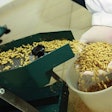The lesser grain borer (Fig. 1) and the red flour beetle (Fig. 2) are two major pests of stored grain in the United States, and are often combated with phosphine fumigation. These fumigations are starting to fail, raising questions about their effectiveness. Resistance in stored-product insect pests has become a major problem in many countries, with very high levels of resistance found in some parts of Asia and Africa and, more recently, in Australia and South America. Drs. George Opit, Thomas Phillips, Mahbub Hasan and Mr. Michael Aikins have conducted studies to see whether this is true in the United States. Their results have been recently published in Journal of Economic Entomology, under the title "Phosphine Resistance in Tribolium castaneum and Rhyzopertha dominica" from stored wheat in Oklahoma.
Growing resistance
In 2009, reports of phosphine fumigation failures in the United States along with the concern caused by high levels of phosphine resistance in many countries motivated a reinvestigation into the level of phosphine resistance in the red flour beetle and lesser grain borer from six counties in Oklahoma. These field insects were tested for phosphine resistance. Nine populations of red flour beetle and five populations of lesser grain borer collected from silos, concrete bins and steel bins were tested. Insects were tested for resistance using an internationally accepted method called FAO Method No. 16. Phosphine gas concentrations in fumigation containers were verified by using a gas chromatographic-flame photometric detector (Fig. 3).
Before this most recent survey, The United Nations Food and Agriculture Organization’s Bruce R. Champ and C. E. Dyte conducted a "Global Survey of Pesticide Susceptibility of Stored Grain Pests" in 1972 through 1973. They found that about 10% of stored-product insect populations sampled in different countries contained phosphine-resistant individuals.
Another survey, simlar to the one conducted in 2009, titled "Pesticide resistance in Tribolium castaneum (Coleoptera: Tenebrionidae) and Rhyzopertha dominica (Coleoptera: Bostrichidae) in Wheat" was conducted by Larry Zettler and Gerrit Cuperus, in 1990. It found found that 1 out of 8 red flour beetle populations and 8 out of 12 lesser grain borer populations collected from 10 Oklahoma counties had phosphine resistance. The report cited phosphine control failures in grain storage structures and suggested that these could have been due either to phosphine resistance or to inefficient fumigation. Even with these findings, use of phosphine in Oklahoma had continued with no effort to document whether the resistance to this fumigant has increased since 1990.
Survey findings
The results of the 2009 survey showed that 89% (8 out of 9) of the red flour beetle populations and 100% (5 out of 5) of the lesser grain borer populations were resistant to phosphine. In fact, in one red flour beetle population and three lesser grain borer populations, at least 80% of individuals fumigated in a test to detect resistance survived the fumigation.
When a field population is 100 times or more resistant than the susceptible population, this is called “strong” phosphine resistance. When dose-response tests were conducted to determine the level of phosphine resistance in these four populations, the red flour beetle population was 119 times more resistant to phosphine. Three lesser grain borer populations, were 254, 910 and 1,519 times more resistant! It is likely that resistant populations of pest species, like these in Oklahoma, occur in other parts of the U.S.
New fumigation levels
Highly resistant population mean that the amount of aluminum phosphide tablets needed in order to properly fumigate stored grain has risen exponentially. The label rate for aluminum phosphide tablets used for space or bulk fumigations in vertical storages such as concrete silos and steel bins is 30 to 140 tablets/1,000 cubic feet, or 40 to 180 tablets/1,000 bushels of grain, respectively.
To kill the red flour beetles that are 119 times more resistant than “normal” insects, it takes fumigating with a concentration of 377 parts per million (ppm) of phosphine gas for 72 hours to kill 99% of the resistant insects. This concentration is equivalent to 15 tablets of aluminum phosphide/1,000 cubic feet. However, at least 30 tablets/1,000 cubic feet or 40 tablets/1,000 bushels need to be used to kill red flour beetles with this level of resistance because aluminum phosphide labeling recommends these minimum numbers of tablets be used in vertical storages.
In the case of lesser grain borers, which were 254, 910 and 1,519 times resistant in three different collections, concentrations of phosphine estimated to kill 99% of these individuals were 573, 2,054 and 3,431 ppm, respectively. These concentrations are equivalent to 23, 83 and 138 tablets/1,000 cubic feet, respectively. Again, at least 30 tablets/1,000 cubic feet or 40 tablets/1,000 bushels need to be used. To maintain the concentrations of phosphine gas mentioned here for three days under field conditions would be difficult due to gas loss from the storage structure, gas sorption to grain, and incomplete reaction of the tablets.
Because a larger number of tablets are going to be required to kill resistant insects, it is likely that the current highest label dose rate for phosphine tablets is no longer effective for the highly resistant populations. Resistance to phosphine discussed here applies to cylinder-based phosphine products as well.
Conclusion
Phosphine gas is an important tool for the management of stored grain pests and many other pests of durable stored agricultural products, and the occurrence of phosphine resistance in pest populations presents challenges to the continued effective use of this fumigant. The presence of highly phosphine-resistant populations of lesser grain borer and red flour beetle in Oklahoma could be an indication of the same in other parts of the United States and North America and an indication that it could develop in areas where resistance may currently not exist but phosphine is commonly used.
What is now required is a survey of key stored-grain insect pest species across the U.S. to determine the presence and extent of phosphine resistance. In addition, a national resistance monitoring program for the U.S. needs to be developed. Resistance monitoring is crucial for a number of reasons, including providing an early warning of resistance, feedback on the success of resistance management activities, diagnosis of phosphine control failures and obtaining information on the likely impact of new phosphine resistance. Resistance monitoring is an important part of keeping the proportion of susceptible individuals in a population as large as possible to ensure continued effective use of phosphine.
Also needed is a phosphine resistance management strategy, such as a rotation plan with other active ingredients or products that may allow for applying phosphine as infrequently as possible to delay the development of resistance where it currently does not exist and to destroy resistant stored-product insect populations where they exist. Research will soon be under way to determine if alternative fumigant gases (eg., sulfuryl fluoride) and residual applied long-acting insecticides (a mixture of chlorpyrifos-methyl [21.6%] and deltamethrin [3.7%]) can be used to kill phosphine-resistant grain pest populations so the use of phosphine can be preserved for the future.


















